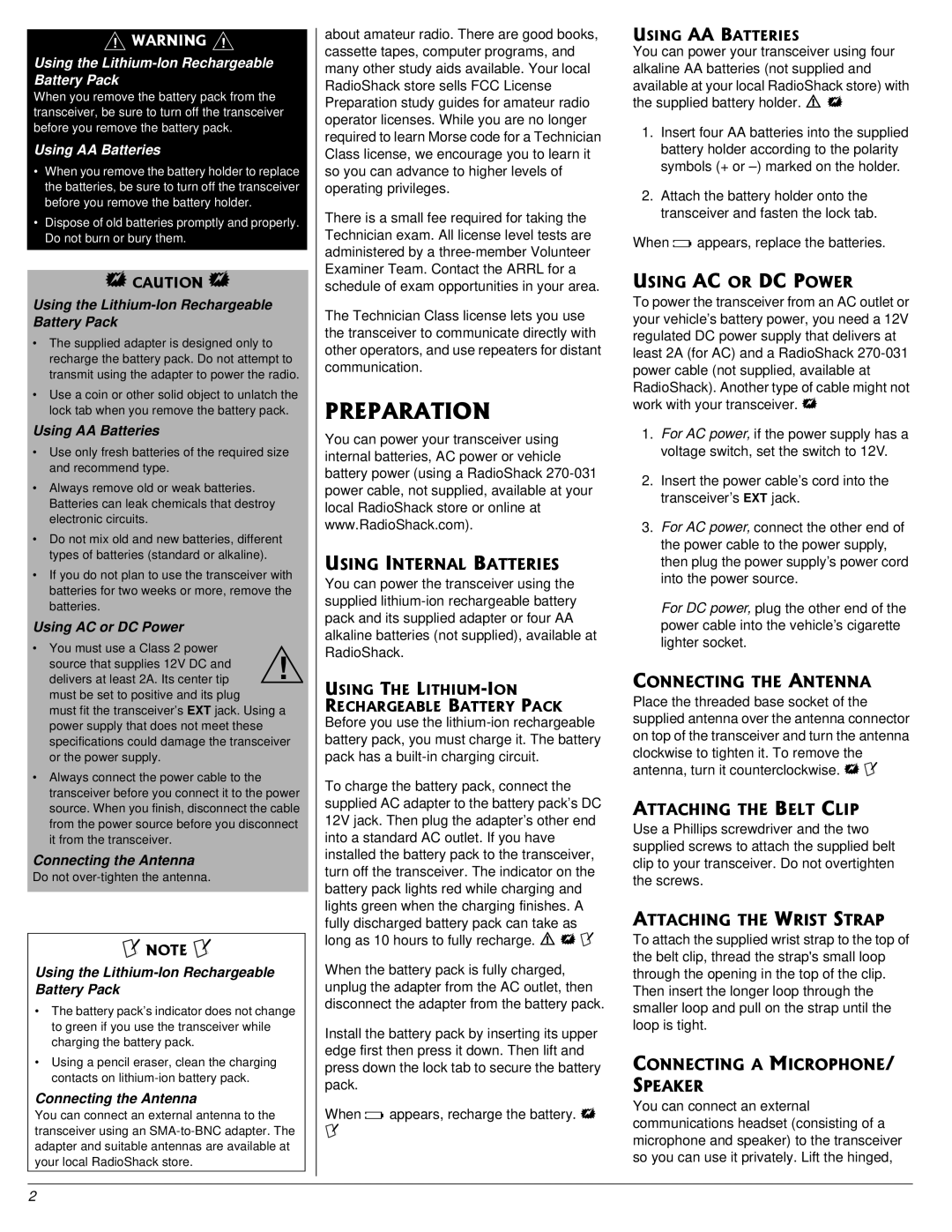
ýR"9#40+0)"R"
Using the Lithium-Ion Rechargeable Battery Pack
When you remove the battery pack from the transceiver, be sure to turn off the transceiver before you remove the battery pack.
Using AA Batteries
•When you remove the battery holder to replace the batteries, be sure to turn off the transceiver before you remove the battery holder.
•Dispose of old batteries promptly and properly. Do not burn or bury them.
."%#76+10".
Using the Lithium-Ion Rechargeable Battery Pack
•The supplied adapter is designed only to recharge the battery pack. Do not attempt to transmit using the adapter to power the radio.
•Use a coin or other solid object to unlatch the lock tab when you remove the battery pack.
Using AA Batteries
•Use only fresh batteries of the required size and recommend type.
•Always remove old or weak batteries. Batteries can leak chemicals that destroy electronic circuits.
•Do not mix old and new batteries, different types of batteries (standard or alkaline).
•If you do not plan to use the transceiver with batteries for two weeks or more, remove the batteries.
Using AC or DC Power
•You must use a Class 2 power
source that supplies 12V DC and | ! |
delivers at least 2A. Its center tip |
must be set to positive and its plug
must fit the transceiver’s EXT jack. Using a power supply that does not meet these specifications could damage the transceiver or the power supply.
•Always connect the power cable to the transceiver before you connect it to the power source. When you finish, disconnect the cable from the power source before you disconnect it from the transceiver.
Connecting the Antenna
Do not
±"016'"±"
Using the
•The battery pack’s indicator does not change to green if you use the transceiver while charging the battery pack.
•Using a pencil eraser, clean the charging contacts on
Connecting the Antenna
You can connect an external antenna to the transceiver using an
about amateur radio. There are good books, cassette tapes, computer programs, and many other study aids available. Your local RadioShack store sells FCC License Preparation study guides for amateur radio operator licenses. While you are no longer required to learn Morse code for a Technician Class license, we encourage you to learn it so you can advance to higher levels of operating privileges.
There is a small fee required for taking the Technician exam. All license level tests are administered by a
The Technician Class license lets you use the transceiver to communicate directly with other operators, and use repeaters for distant communication.
24'2#4#6+10
You can power your transceiver using internal batteries, AC power or vehicle battery power (using a RadioShack
75+0)"+06'40#."$#66'4+'5
You can power the transceiver using the supplied
75+0)"6*'".+6*+7//+10"
4'%*#4)'#$.'"$#66'4;"2#%-
Before you use the
To charge the battery pack, connect the supplied AC adapter to the battery pack’s DC 12V jack. Then plug the adapter’s other end into a standard AC outlet. If you have installed the battery pack to the transceiver, turn off the transceiver. The indicator on the battery pack lights red while charging and lights green when the charging finishes. A fully discharged battery pack can take as long as 10 hours to fully recharge. R". ±
When the battery pack is fully charged, unplug the adapter from the AC outlet, then disconnect the adapter from the battery pack.
Install the battery pack by inserting its upper edge first then press it down. Then lift and press down the lock tab to secure the battery pack.
When • appears, recharge the battery. .#
±
75+0)"##"$#66'4+'5
You can power your transceiver using four alkaline AA batteries (not supplied and available at your local RadioShack store) with the supplied battery holder. R".
1.Insert four AA batteries into the supplied battery holder according to the polarity symbols (+ or
2.Attach the battery holder onto the transceiver and fasten the lock tab.
When • appears, replace the batteries.
75+0)"#%"14"&%"219'4
To power the transceiver from an AC outlet or your vehicle’s battery power, you need a 12V regulated DC power supply that delivers at least 2A (for AC) and a RadioShack
1.For AC power, if the power supply has a voltage switch, set the switch to 12V.
2.Insert the power cable’s cord into the transceiver’s EXT jack.
3.For AC power, connect the other end of the power cable to the power supply, then plug the power supply’s power cord into the power source.
For DC power, plug the other end of the power cable into the vehicle’s cigarette lighter socket.
%100'%6+0)"6*'"#06'00#
Place the threaded base socket of the supplied antenna over the antenna connector on top of the transceiver and turn the antenna clockwise to tighten it. To remove the antenna, turn it counterclockwise. . ±
#66#%*+0)"6*'"$'.6"%.+2
Use a Phillips screwdriver and the two supplied screws to attach the supplied belt clip to your transceiver. Do not overtighten the screws.
#66#%*+0)"6*'"94+56"564#2
To attach the supplied wrist strap to the top of the belt clip, thread the strap's small loop through the opening in the top of the clip. Then insert the longer loop through the smaller loop and pull on the strap until the loop is tight.
%100'%6+0)"#"/+%412*10'1 52'#-'4
You can connect an external communications headset (consisting of a microphone and speaker) to the transceiver so you can use it privately. Lift the hinged,
2
